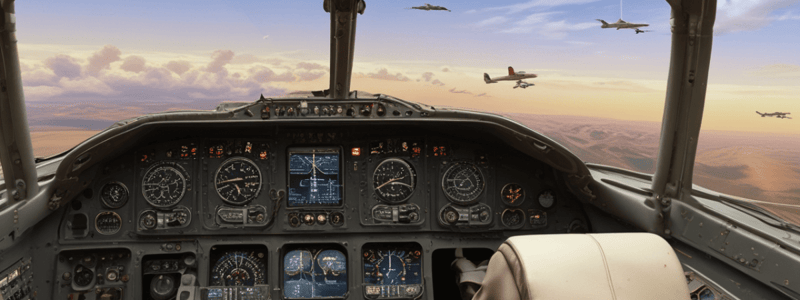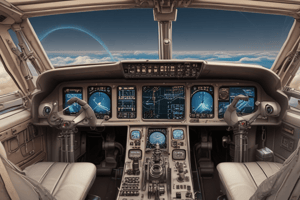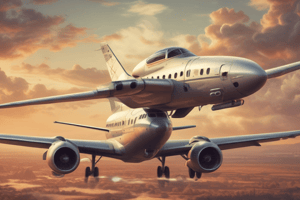Podcast
Questions and Answers
What is the primary benefit of trim systems in terms of pilot workload?
What is the primary benefit of trim systems in terms of pilot workload?
What is the main limitation of autopilot systems in aircraft control?
What is the main limitation of autopilot systems in aircraft control?
What is the primary role of spoilers in aircraft control?
What is the primary role of spoilers in aircraft control?
What is the main benefit of integrating autopilot and trim systems in aircraft control?
What is the main benefit of integrating autopilot and trim systems in aircraft control?
Signup and view all the answers
What is the key to ensuring safe flight operations in modern aviation?
What is the key to ensuring safe flight operations in modern aviation?
Signup and view all the answers
What is the primary purpose of autopilot systems in aircraft control?
What is the primary purpose of autopilot systems in aircraft control?
Signup and view all the answers
What is the main benefit of using autopilot systems during flight?
What is the main benefit of using autopilot systems during flight?
Signup and view all the answers
What is the primary role of trim systems in reducing pilot error?
What is the primary role of trim systems in reducing pilot error?
Signup and view all the answers
What is the key to safe and efficient flight operations in modern aviation?
What is the key to safe and efficient flight operations in modern aviation?
Signup and view all the answers
What is the primary benefit of the dual functionality of spoilers in aircraft control?
What is the primary benefit of the dual functionality of spoilers in aircraft control?
Signup and view all the answers
The safety of mechanical aircraft control systems is not affected by regular maintenance.
The safety of mechanical aircraft control systems is not affected by regular maintenance.
Signup and view all the answers
Fly-by-wire systems are typically less reliable than mechanical aircraft control systems.
Fly-by-wire systems are typically less reliable than mechanical aircraft control systems.
Signup and view all the answers
Aircraft control systems are only used in modern aircraft.
Aircraft control systems are only used in modern aircraft.
Signup and view all the answers
Trim systems are used to reduce pilot workload.
Trim systems are used to reduce pilot workload.
Signup and view all the answers
Pilot input is directly connected to the control surfaces in fly-by-wire systems.
Pilot input is directly connected to the control surfaces in fly-by-wire systems.
Signup and view all the answers
Aircraft control systems are only used during takeoff and landing.
Aircraft control systems are only used during takeoff and landing.
Signup and view all the answers
The primary concern in aviation is aircraft speed.
The primary concern in aviation is aircraft speed.
Signup and view all the answers
Mechanical aircraft control systems provide intangible feedback to pilots.
Mechanical aircraft control systems provide intangible feedback to pilots.
Signup and view all the answers
Fly-by-wire systems are less intuitive than mechanical aircraft control systems.
Fly-by-wire systems are less intuitive than mechanical aircraft control systems.
Signup and view all the answers
The integration of aircraft control systems into aircraft design is a luxury of modern engineering.
The integration of aircraft control systems into aircraft design is a luxury of modern engineering.
Signup and view all the answers
How do trim systems contribute to flight safety, and what benefit do they provide to pilots?
How do trim systems contribute to flight safety, and what benefit do they provide to pilots?
Signup and view all the answers
What is the role of autopilot systems in enhancing flight safety, and what limitation must pilots be aware of?
What is the role of autopilot systems in enhancing flight safety, and what limitation must pilots be aware of?
Signup and view all the answers
How do spoilers contribute to safety during rapid descents and preparation for landing?
How do spoilers contribute to safety during rapid descents and preparation for landing?
Signup and view all the answers
What is essential for pilots to manage the complexities of modern aviation safely?
What is essential for pilots to manage the complexities of modern aviation safely?
Signup and view all the answers
How do aircraft control systems contribute to overall flight safety?
How do aircraft control systems contribute to overall flight safety?
Signup and view all the answers
What promise do the integration of aircraft control systems and continuous advancements in technology hold for future flight operations?
What promise do the integration of aircraft control systems and continuous advancements in technology hold for future flight operations?
Signup and view all the answers
What is the relationship between pilot workload and pilot error, and how do aircraft control systems address this?
What is the relationship between pilot workload and pilot error, and how do aircraft control systems address this?
Signup and view all the answers
How do aircraft control systems enable pilots to maintain control of the aircraft during critical phases of flight?
How do aircraft control systems enable pilots to maintain control of the aircraft during critical phases of flight?
Signup and view all the answers
What is the key to ensuring that pilots can interact effectively with aircraft control systems?
What is the key to ensuring that pilots can interact effectively with aircraft control systems?
Signup and view all the answers
How do aircraft control systems contribute to the overall efficiency of flight operations?
How do aircraft control systems contribute to the overall efficiency of flight operations?
Signup and view all the answers
Study Notes
Advanced Control Techniques in Aircraft
- Advanced control systems enhance aircraft performance and ease pilot workload by providing precision and sophisticated engineering.
- Mechanical systems have been the backbone of aviation for decades, offering a direct, tangible connection to the aircraft's control surfaces.
- Mechanical systems' limitations become apparent as aircraft performance expectations increase.
Mechanical vs. Fly-by-Wire Systems
- Mechanical systems use cables and pulleys to translate control stick movements into immediate responses.
- Fly-by-wire systems replace mechanical linkages with electronic signals, offering precision, programmability, and instantaneous responses.
- Fly-by-wire systems provide swift execution and corrective actions, making them superior in advanced maneuvers.
Benefits of Fly-by-Wire Systems
- Fly-by-wire systems offer responsiveness in advanced maneuvers, allowing for corrective actions that mechanical systems may not match.
- They provide pilots with smoother, more responsive control, and reduce the aircraft's weight.
- Fly-by-wire systems come with built-in redundancies and sophisticated software that can prevent dangerous maneuvers, enhancing flight safety.
Leading-Edge Devices
- Leading-edge devices, such as slats or Krueger flaps, adjust the wing's contour for optimal aerodynamic efficiency.
- They extend during takeoff and landing to increase lift, preventing stalls and enhancing control and safety.
Spoilers
- Spoilers disrupt lift and increase drag, aiding in descent and speed reduction.
- They contribute to safety by giving pilots greater command over the aircraft's altitude and attitude, particularly during rapid descents and in preparation for landing.
Trim Systems
- Trim systems relieve pilots from the need to apply constant control pressure, allowing them to maintain a desired pitch attitude without holding the controls manually.
- By reducing pilot workload and fatigue, trim systems lessen the likelihood of pilot error, contributing to overall flight safety.
Autopilot Systems
- Autopilot systems manage various flight parameters, from maintaining level flight to following complex flight paths.
- They allow pilots to focus on other critical tasks, but it is crucial for pilots to understand their limitations and remain ready to assume manual control when necessary.
Aircraft Stability and Control
- Advanced control systems serve as the pilot's extended senses and hands, responding precisely to inputs and automating various aspects of flight.
- These systems provide pilots with real-time data, predictive analyses, and automatic reactions to certain flight conditions, augmenting their control and decision-making abilities.
- The union of advanced control systems and flight safety is crucial for ensuring a safe and enjoyable flight experience.
Enhanced Flight Control Techniques
- Advanced control techniques can enhance aircraft performance and ease pilot workload.
- Mechanical systems have been the backbone of aviation for decades, offering pilots a direct, tangible connection to the aircraft's control surfaces.
- Limitations of mechanical systems become apparent when pushing envelopes and expecting more from aircraft.
Mechanical vs. Fly-by-Wire Systems
- Mechanical systems translate control stick movements to cables and pulleys, delivering immediate responses.
- Fly-by-wire systems replace cables with electronic signals, offering precision and programmability for complex maneuvers.
- Key advantage of fly-by-wire systems is their responsiveness in advanced maneuvers, allowing for swift execution and corrective actions.
Quieting Adverse Yaw
- Adverse yaw is a drag-inducing effect that occurs during turns.
- Fly-by-wire systems utilize algorithms to blend aileron and rudder inputs, mitigating adverse yaw and keeping turns crisp and efficient.
Techniques for Optimized Turns
- Advanced training introduces techniques that utilize fly-by-wire benefits to harmonize desired trajectory with the aircraft's automated response.
- These techniques allow for turn performance that feels almost preternatural.
The T-tail Design and Flutter Prevention
- The T-tail design is a structural configuration that prevents flutter, a potentially disastrous oscillation of control surfaces.
- Case studies illustrate the benefits of T-tail designs in safeguarding against flutter, particularly when combined with fly-by-wire systems.
Aircraft Stability and Control
- Advanced control systems serve as the pilot's extended senses and hands, responding precisely to inputs and automating various aspects of flight to enhance safety and efficiency.
- These systems provide pilots with real-time data, predictive analyses, and automatic reactions to certain flight conditions, augmenting their control and decision-making abilities.
Contrasting Mechanical and Fly-by-Wire Systems
- Mechanical systems encompass traditional cables and pulleys that directly link the pilot's controls to the aircraft's flight surfaces.
- Fly-by-wire systems replace these mechanical linkages with electronic signals, affording pilots smoother, more responsive control, and reducing the aircraft's weight.
Leading-Edge Devices and Spoilers
- Leading-edge devices, such as slats or Krueger flaps, adjust the wing's contour for optimal aerodynamic efficiency during takeoff and landing.
- Spoilers, located on the wings, disrupt lift to drastically reduce landing distance, adding a fundamental safety feature, especially in shorter runways or emergency situations.
Safety Considerations
- Advanced control systems are indispensable tools in the pursuit of safer air travel, making every flight as fail-safe as possible.
- Integration of these systems into aircraft design is not merely a luxury of modern engineering but a fundamental expectation.
- Case scenarios illustrate the critical role of advanced control systems in detecting and responding to hazardous situations, such as wind shear during landing approaches.
Enhanced Flight Control Techniques
- Advanced control techniques can enhance aircraft performance and ease pilot workload.
- Mechanical systems offer a direct, tangible connection to the aircraft's control surfaces, but have limitations in advanced maneuvers.
- Fly-by-wire systems replace mechanical linkages with electronic signals, offering precision and programmability.
Fly-by-Wire Systems
- Advantages of fly-by-wire systems include:
- Responsiveness in advanced maneuvers
- Ability to program complex maneuvers
- Swift execution and corrective actions
- Fly-by-wire systems can mitigate adverse yaw by blending aileron and rudder inputs.
Techniques for Optimized Turns
- Advanced training introduces techniques that utilize fly-by-wire benefits to harmonize desired trajectory with automated response.
- Techniques allow for turn performance that feels almost preternatural.
T-tail Design and Flutter Prevention
- The T-tail design prevents flutter, a potentially disastrous oscillation of control surfaces.
- T-tail designs have proven their worth in commercial jets and private aircraft, particularly when combined with fly-by-wire systems.
Aircraft Stability and Control
- Advanced control systems serve as the pilot's extended senses and hands, responding precisely to inputs and automating various aspects of flight.
- These systems provide pilots with real-time data, predictive analyses, and automatic reactions to certain flight conditions.
Mechanical and Fly-by-Wire Systems
- Mechanical systems use traditional cables and pulleys to link the pilot's controls to the aircraft's flight surfaces.
- Fly-by-wire systems replace mechanical linkages with electronic signals, offering smoother, more responsive control and reducing the aircraft's weight.
Leading-Edge Devices and Spoilers
- Leading-edge devices, such as slats or Krueger flaps, adjust the wing's contour for optimal aerodynamic efficiency.
- Spoilers can drastically reduce landing distance and assist in roll control, adding another layer of safety.
Safety Features
- Advanced control systems can detect wind patterns and automatically adjust control surfaces to compensate, guiding the aircraft to a safe landing.
- Trim systems relieve pilots from the need to apply constant control pressure, reducing pilot workload and fatigue.
- Autopilot systems can manage various flight parameters, allowing pilots to focus on other critical tasks.
- Ongoing training and a deep understanding of how these systems function are essential for pilots to manage the complexities of modern aviation safely.
Studying That Suits You
Use AI to generate personalized quizzes and flashcards to suit your learning preferences.
Related Documents
Description
Explore advanced control techniques to enhance aircraft performance and ease pilot workload, mastering state-of-the-art flight systems.




